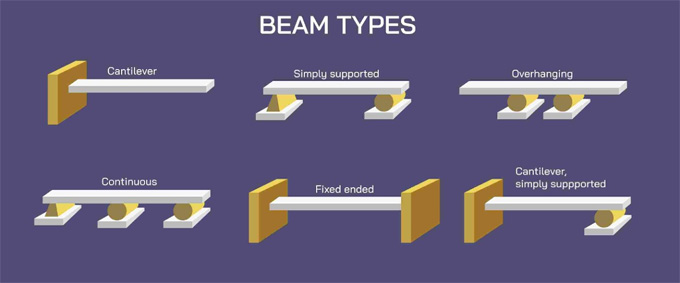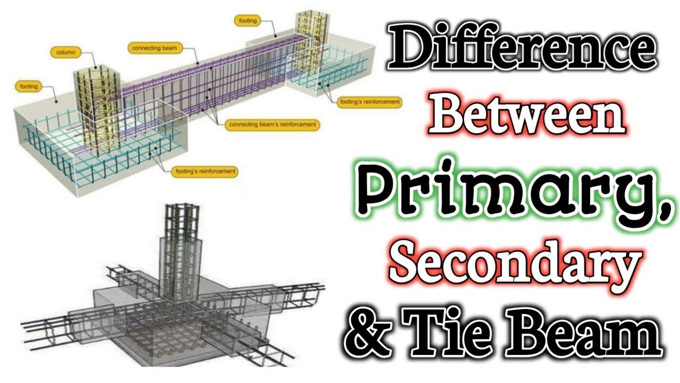
What is the difference between Primary, Secondary and Tie Beam

The beams have the ability to bear the bending and shear forces and distribute the structural loads of the building evenly. Beams help to prevent the building structure from collapsing and ensure the long-term durability of the construction structure.

Reinforced steel, wood or concrete has been used to construct beams for the building structure. There are three types of beams that have been used in the construction work in general, including primary beams, secondary beams and tie beams.
Concept about primary beams
The primary beams act as the main load-bearing component of the building structure, which helps to support the weight of the walls, slabs, and secondary beams, as well as transfers those loads to the columns or the foundation structure.
Key characteristics of the primary beams
➢ The primary beams have been made with reinforced concrete or steel.
➢ The primary beams have greater depth as compared to the secondary beams, which enhances their load-bearing capacity.
Concept about secondary beams
The secondary beams act as the supporting beams, which help to connect with the primary beam. The secondary beam has the ability to transfer the slab load to the main beam, thus distributing the overall load.
Key effectiveness of the secondary beam reinforcement in construction work
➢ The reinforcement of the secondary beam within the construction structure is effective in reducing the load on the primary beams, thus helping to improve the overall stability of the construction structure.
➢ The secondary beam reinforcement is also effective in strengthening the flooring system.
➢ The secondary beams also play an important role in reducing deflection, which helps to improve the overall stability of the construction structure.
➢ Because of the higher load-distributing capacity, the secondary beam reinforcement has been used in the frame structures.
Concept about tie beams
The horizontal beams used in the construction structure are known as the tie beams, which are supported by two or more rafters in the roof structure or roof truss. The tie beam plays an important role in reinforcing the entire building structure. In addition, the tie beam helps to keep the column stable, as well as prevent the columns from buckling because of the lateral forces.
Key characteristics of the tie beams
➢ The tie beams have been used in high-wind areas or areas with seismic activity to maintain stability of the building structure.
➢ The slenderness ratio of columns can be reduced by using the tie beams.
➢ The tie beams help to stiffen the building structure, thus providing supports against the lateral forces.
➢ The tie beams have been used in the roof trusses and damp-proof courses at the plinth level.
Discuss the difference between the primary, secondary and tie beams
The primary beams, secondary beams and tie beams can be differentiated on the basis of their different features within the construction work, which are as follows:
Based on the key functions
➢ The key function of the primary beam is to transfer the loads from secondary beams or slabs to the columns.
➢ The load has been transferred from slabs to the primary beams with the help of the secondary beams.
➢ The tie beams are able to connect the columns of the construction structure, which helps to prevent buckling.
Based on the placement of the beams
➢ In the construction structure, the primary beams have been placed and supported by the columns.
➢ On the other hand, the secondary beams have been supported by the primary beams.
➢ The tie beam has been placed in the middle of two or more columns.
Based on the load-bearing capacity of the beams
➢ As compared to the other types of beams used in construction work, the primary beams have higher load-bearing capacity.
➢ The secondary beams have medium load-bearing capacity.
➢ On the other hand, the tie beam is not able to resist direct floor loads.
Based on the size
➢ The primary beams are available in larger sizes as compared to the other types of beams.
➢ The secondary beams are smaller in size as compared to the primary beams.
➢ On the other hand, the size of the tie beams has varied on the basis of the structure.
Based on the purposes of the beams for the construction work
➢ The main purpose of using the primary beam is to provide main structural support to the construction structure.
➢ The secondary beam focuses on the distribution of the loads within the construction structure.
➢ Whereas, the lateral support to the column has been provided by the tie beams.
To learn more, watch the following video tutorial.
Video Source: My Engineering Support
Based on the relevant IS code for the beams
➢ The relevant IS code for the primary beams is IS 456:2000, IS 13920:2016.
➢ Whereas, the relevant IS code for the secondary beams is IS 800:2007, IS 456:2000.
➢ On the other hand, in the case of the tie beam, the relevant IS code is IS 2911:2010.


